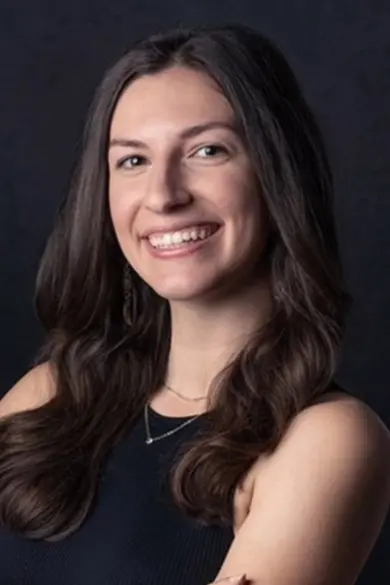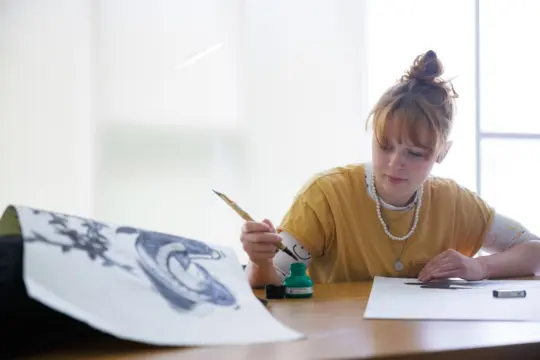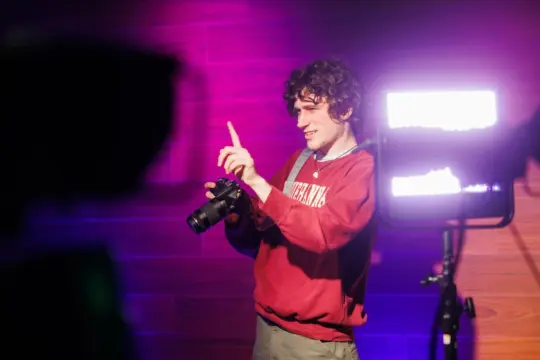Graphic Design
Enter the world that needs and feeds your creative self.
Named a Best Graphic Design School
Susquehanna University’s graphic design program has been named a 2024 Graphic Design USA Top Design School!
Learn what sets us apart and how Susquehanna’s graphic design degree can place you on the path to success.

Endless Possibilities for Designers in the Age of the Image
Visual identity is becoming increasingly more valuable, and a Bachelor of Arts or a Bachelor of Fine Arts degree from Susquehanna will take you far.

SUsquehanna By the Numbers
More Than Metrics
Where Passion Meets Purpose
Straight from the Nest
“With my graphic design major, I have been able to produce a well-rounded portfolio that makes me a candidate who will stand out in job interviews.”
— Kristina Kerschner ’25
“What stands out about my majors at Susquehanna is that they have smaller communities and that really gives us the opportunity to dive into each other’s work, get to know the people who are in our community and help better each other.”
— Allison Himler ’26
“I have learned how to think critically, apply classroom skills to real-world projects and problems and expand my knowledge of different styles of art. Classes are set up in an agency-style setting with strict deadlines and projects restraints. I have no doubt I will be able to keep up with fast-paced, graphic-design environments.”
— Nickie Vertigan ’23
“I think Susquehanna’s program has done an amazing job of not only preparing their students to feel comfortable searching for jobs, but also teaching them how to excel in those jobs in a professional setting. Our projects mimic realistic assignments we would get in a wide variety of roles as a designer.”
— Kristina Moncelsi ’24
“I hope to give back to SU in the same way that alumni have given back to me — giving current students a leg up in finding a first job, offering advice to young professionals and peers and remaining active with the current SU student body. These are all things I hope to continue as I advance in my career, because I wouldn’t be where I am today without the support that SU alumni gave me while I was a student.”
— Alyson Lawrence ’20
Student Work
faqs
Students considering the BFA in graphic design major (as well as Studio Art majors) must submit a portfolio, even if they are current Susquehanna students hoping to change their major. Students planning to enter the BA in graphic design program are not required to submit a portfolio at this time. BFA students who do not submit a portfolio will be automatically placed in the BA program and must submit a portfolio before joining the BFA program or perform appropriately in introductory coursework.
The BFA is the preferred professional degree for those who wish to have a career in graphic design. The BFA in graphic design program at Susquehanna is designed for students who wish to have a high-impact career creating amazing print and digital work for elite agencies in cities such as New York, Los Angeles, Philadelphia, Boston, San Francisco, and Washington, W.C. The BFA program is rigorous, exciting, intense and known nationally for producing some of the most successful graphic designers in the country.
Students who choose the BA in graphic design program do not necessarily intend to pursue a career as a professional graphic designer (though for highly talented students such an outcome is possible). Rather, they hope to acquire professional design skills in order to enhance a career in a design-adjacent field. In other words, students in the BA program are expected to be double-majors. The most popular pairings are with communications advertising, editing and publishing, luxury brand marketing and management, computer science, and creative writing.
We have found that the versatility of our unique Central Curriculum allows good students to take all of the additional departmental classes they want AND complete a minor outside the department. The freedom to pursue multiple interests and customize your educational experience is the most powerful aspect of a liberal arts institution — we’ve found that the professional world and graduate programs agree with us.
Absolutely! Many graphic design majors are engaged in multiple disciplines. Students enrolled in the intense, pre-professional BFA in graphic design program are less likely to double-major than their counterparts in the BA program, where a double major is encouraged and expected. Some of the most capable graphic design students have paired their design degree with one in business, computer science, creative writing, history, or even the traditional sciences.
We use top of the line Apple iMacs with large 27″ displays and free access to the Adobe Creative Suite, which includes Illustrator, Photoshop, InDesign, XD, Bridge, Premiere, After Effects, Dreamweaver, Flash and Acrobat. We also have multiple Wacom Cintiq HD touch displays for those students who want to draw directly onto the screen. Our labs have key-card access and are designated for the use of graphic design students only. Each lab is outfitted with scanners, projectors, and wide format Epson professional printers. We do NOT charge students for color printing!
As for software, we teach it from scratch. We don’t mind at all if you’ve never used any of the Adobe software products before. In fact, we don’t care if you’ve never used an Apple computer either. We’ll teach you everything you need to know.
The program centers on the idea of blending conceptual problem solving with visual style as it relates to print and digital interactive (web) design. Our graduates learn to design in a way that allows them to tackle virtually any problem in any format and solve it in the most appropriate and creative way. We are not solely focused on any one particular “genre” of design. Our unique approach, honed for more than two decades, allows us to produce graduates who not only land top national-level design jobs, but also ascend to senior leadership positions such as art director and creative director with astonishing regularity.
The measure of any graphic design program is not whether the graduates get jobs — any and all programs make those sorts of vague claims. At Susquehanna we tout our unmatched industry placement rate and share the names, faces and workplaces of countless alumni so you can see our success with your own eyes.
Yes, you can. Simply submit your materials for application to the Department of Art and Design when you apply for a transfer to Susquehanna. However, you should be aware that you may not receive credit for the art or design classes you have taken at another institution; and some students may be asked to start at the beginning of our curriculum. A reasonable expectation is that students who transfer to the graphic design major at Susquehanna, regardless of their current status, should expect to be here for at least three years.
Featured Alumni
Plan Your Classroom
Program Resources
- Graphic designer
- Art/creative director
- Visual identity designer
- UI/UX designer
- Advertising and marketing designer














































